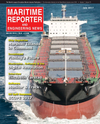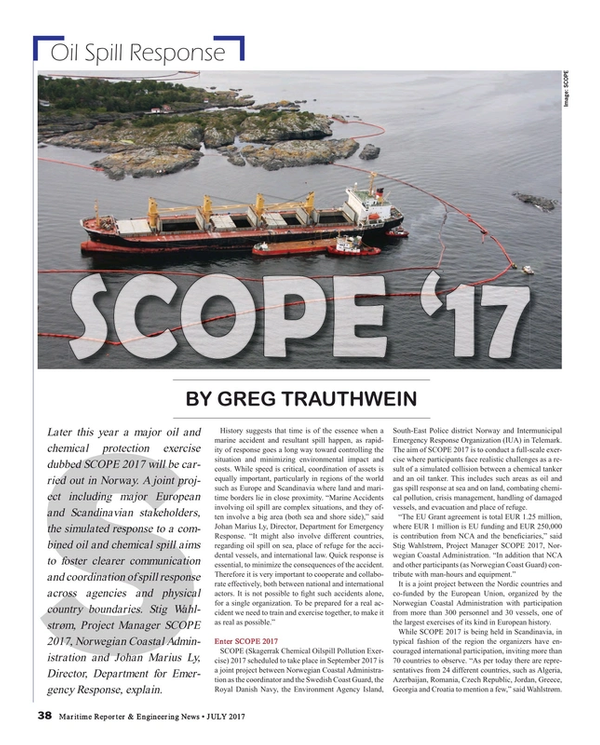Later this year a major oil and chemical protection exercise dubbed SCOPE 2017 will be carried out in Norway. A joint project including major European and Scandinavian stakeholders, the simulated response to a combined oil and chemical spill aims to foster clearer communication and coordination of spill response across agencies and physical country boundaries. Stig Wahlstrøm, Project Manager SCOPE 2017, Norwegian Coastal Administration and Johan Marius Ly, Director, Department for Emergency Response, explain.
History suggests that time is of the essence when a marine accident and resultant spill happen, as rapidity of response goes a long way toward controlling the situation and minimizing environmental impact and costs. While speed is critical, coordination of assets is equally important, particularly in regions of the world such as Europe and Scandinavia where land and maritime borders lie in close proximity. “Marine Accidents involving oil spill are complex situations, and they often involve a big area (both sea and shore side),” said Johan Marius Ly, Director, Department for Emergency Response. “It might also involve different countries, regarding oil spill on sea, place of refuge for the accidental vessels, and international law. Quick response is essential, to minimize the consequences of the accident. Therefore it is very important to cooperate and collaborate effectively, both between national and international actors. It is not possible to fight such accidents alone, for a single organization. To be prepared for a real accident we need to train and exercise together, to make it as real as possible.”
Enter SCOPE 2017
SCOPE (Skagerrak Chemical Oilspill Pollution Exercise) 2017 scheduled to take place in September 2017 is a joint project between Norwegian Coastal Administration as the coordinator and the Swedish Coast Guard, the Royal Danish Navy, the Environment Agency Island, South-East Police district Norway and Intermunicipal Emergency Response Organization (IUA) in Telemark. The aim of SCOPE 2017 is to conduct a full-scale exercise where participants face realistic challenges as a result of a simulated collision between a chemical tanker and an oil tanker. This includes such areas as oil and gas spill response at sea and on land, combating chemical pollution, crisis management, handling of damaged vessels, and evacuation and place of refuge.
“The EU Grant agreement is total EUR 1.25 million, where EUR 1 million is EU funding and EUR 250,000 is contribution from NCA and the beneficiaries,” said Stig Wahlstrøm, Project Manager SCOPE 2017, Norwegian Coastal Administration. “In addition that NCA and other participants (as Norwegian Coast Guard) contribute with man-hours and equipment.”
It is a joint project between the Nordic countries and co-funded by the European Union, organized by the Norwegian Coastal Administration with participation from more than 300 personnel and 30 vessels, one of the largest exercises of its kind in European history.
While SCOPE 2017 is being held in Scandinavia, in typical fashion of the region the organizers have encouraged international participation, inviting more than 70 countries to observe. “As per today there are representatives from 24 different countries, such as Algeria, Azerbaijan, Romania, Czech Republic, Jordan, Greece, Georgia and Croatia to mention a few,” said Wahlstrøm. “In addition to the observers program, two vessels from Germany and one from EU will participate.”
In general an increasing level of shipping traffic has spurred concern in the local maritime communities, and in particular the accident involving M/V Full City in July 2009 on the coast of Langesund illustrated the need for preparedness in dealing with accidents across national borders. (See below).,
“The exercise will involve resources from Norway, Sweden, Denmark and Germany in addition to vessels and services from EMSA and the EU,” said Wahlstrøm. “As the scenario is based on a collision between an oil tanker and a chemical tanker there will be both a chemical spill and an oil spill. The chemical spill is handled by using MIRG teams (Maritime Incidents Response Group), a team consisting of specially trained fire-fighters in chemical protection suits that will be deployed to the stricken chemical tanker by helicopter or vessel. Further the chemical tanker will be towed to a port of refuge assisted by an emergency towing vessel. The oil spill will be handled both at sea and on the shoreline. Vessels will be deployed to tow oil booms and use oil skimmers, and a shoreline response will be organized and personnel and equipment will take part.”
Cleaning Up
While cleaning up after ship accidents if far from a perfected science, there have been leaps in capability over the years based on real world experience.
“In general technologies both for mechanical recovery and chemical dispersion have come a long way in terms of efficiency (and impact) over the last 40 years” said Ly. “There are now oil boom systems (like Current Buster) that will collect oil efficiently up to four to five knots, there are oil recovery skimmers able to efficiently recover high viscous oil products.”
While mechanical and chemical means to break up and collect spills have come a long way, Ly pointed to spill detection technologies, technologies that allow clean up operations to be conducted in poor conditions and at night, that have been equally crucial in advancing the art.
“In terms of overall efficiency, the development of ship-borne oil detection radars and IR systems has resulted in being able to undertake oil recovery operations also at night and in bad visibility,” said Ly. “The use of drones will also make this feasible. There still is a large effort put into improving the technologies, and while there is perhaps not a quantum leap on the horizon, but the continuous focus on improvement of the both mechanical recovery and chemical dispersion driven by both the authorities and the oil companies will give results.” In Norway, a country with a long history of environmental sensitivity, Ly said mechanical recovery, using oil booms and skimmers, and chemical dispersion are both employed, and ultimately the decision to use one or both comes down to a net environmental benefit analysis. “In Norway, the offshore oil industry has built up a capacity for both mechanical recovery and dispersants, whereas the NCA in preparedness for possible shipping incidents has mechanical recovery as our primary strategy,” said Ly.
MV Full City: Accident Report
- Location: Langesund/Såstein
- Date: July 31, 2009
- Category: Grounding
- Area: Norwegian Territorial Waters
- IMO#: 9073672
The Panama-registered cargo vessel Full City received the assignment to ship artificial fertilizer from Herøya in Porsgrunn to Guatemala on 23 July 2009. The vessel was berthed in Newport, England at the time. As early as one week before the vessel entered Norwegian waters, the local Norwegian agent referred the vessel to anchor at Såstein anchorage while awaiting clearance to birth at Herøya. The agent stuck to Såstein as the anchorage site, even though the weather forecasts increasingly indicated that the area would be exposed to strong winds and high waves.
Before the vessel entered Norwegian waters, contact was established between the vessel and the Norwegian authorities (Brevik VTS) in accordance with the international guidelines that apply to permission to enter a VTS center’s area of operation. In its communication with the vessel Brevik VTS did not make it clear that the anchorage referred to was outside its area of operation.
Just before midnight on 30 July 2009, Full City lost its anchor hold and started dragging under the impact of strong south-easterly winds and high waves. Because it was dragging in a south-easterly direction quite close to the shore, there was little opportunity to regain control once the vessel had started dragging. The vessel ran aground at Såstein after dragging anchor for 35 minutes.
The AIBN believes that different role expectations contributed to the master’s decision to let the vessel lie at anchor at Såstein in strong winds. The input from the agent and the VTS center influenced the master’s expectation that the vessel should lie at anchor. This did not tally with the expectations of the agent and the VTS center that the master had to make his own independent assessments.
In the AIBN’s view, the greatest potential for preventing similar incidents in Norwegian waters and for safeguarding Norwegian environmental protection interests can be found in the organization and execution of the authorities’ vessel traffic service. If this service is given a more active role, the AIBN believes that both agents and ships can be guided into making decisions that better ensure safety.



